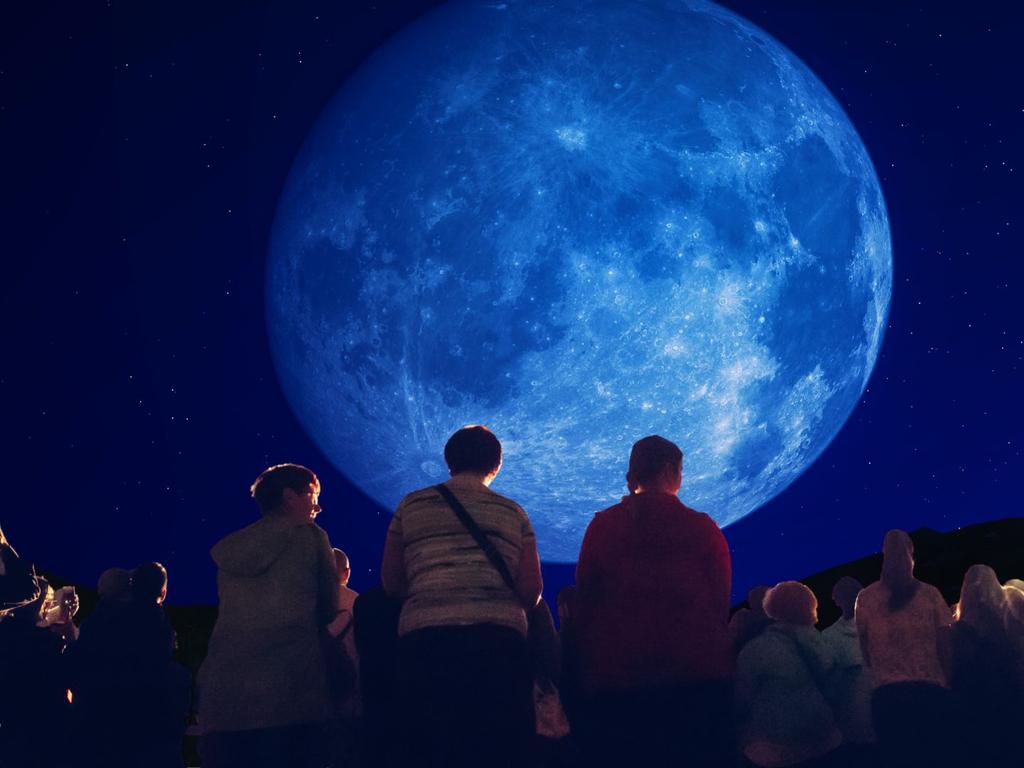Understanding the Super Blue Moon Phenomenon
The super blue moon is a fascinating astronomical event that captivates observers worldwide due to its rarity and appearance. To thoroughly understand this phenomenon, it is essential to break it down into its two main components: the supermoon and the blue moon.
A supermoon occurs when the Moon is at or near its closest point to Earth, a position known as perigee, while also appearing full. This proximity makes the Moon appear larger and brighter than usual in the night sky. Specifically, a supermoon can appear up to 14% larger and 30% brighter than a normal full moon. This phenomenon occurs due to the elliptical nature of the Moon’s orbit around the Earth. Approximately one-quarter of all full moons are classified as supermoons, making them a relatively common occurrence.
In contrast, a blue moon is a rarer event. A blue moon happens when there are two full moons within the same calendar month. Since a full moon cycle lasts about 29.5 days, most months only contain one full moon. The occurrence of a second full moon in a single month happens approximately once every 2.7 years, or about 3% of the time, earning it the term “once in a blue moon.” It is important to note that a blue moon does not actually appear blue; it retains the same coloration as any other full moon.
When these two phenomena align, we witness the exceptional event known as a super blue moon. The simultaneous occurrence of a supermoon and a blue moon enhances its significance and makes it a noteworthy spectacle for astronomers and moon enthusiasts. The upcoming super blue moon in August 2024 promises a unique celestial display, providing observers with a remarkable opportunity to witness these conditions coming together. This rare alignment underscores the importance of understanding the individual components of the phenomenon, setting the stage for appreciating the grandeur of the event.
The Rarity of the Super Blue Moon
Super blue moons are astronomical events that enthrall both enthusiasts and casual sky watchers due to their infrequency and unique characteristics. While supermoons—which occur when the moon is at its closest approach to Earth in its elliptical orbit—happen relatively regularly, blue moons (the second full moon in a calendar month) are much rarer. The combination of these two phenomena into a super blue moon creates an astronomical spectacle that captivates the globe. The last super blue moon, occurring in August 2023, was an event marked on many a calendar, underscoring the uniqueness and anticipation surrounding the upcoming occurrence in August 2024.
Historically, super blue moons have been events that stir curiosity and generate significant interest. Prior to the August 2023 event, such phenomena have been recorded sporadically, with notable instances stargazed and documented by observers. These occurrences happen about once every decade, although not strictly following a fixed interval, contributing to their rarity and the eagerness with which they are awaited.
The terms “supermoon” and “blue moon” also carry folklore and historical significance. In several cultures, blue moons are associated with mysterious and magical occurrences, often appearing in literature and art as symbols of rarity and wonder. Supermoons, due to their larger and brighter appearance, have been linked to various myths and legends, often associated with changes in behavior or natural occurrences.
Comparatively, other rare astronomical events, such as solar eclipses or planetary alignments, also attract significant attention but usually come with more predictable cycles and frequencies. The erratic nature of super blue moons adds to their allure, offering a sense of unpredictability and natural wonder. Thus, the super blue moon is not just an astronomical event but also a cultural and symbolic treasure, a rare celestial phenomenon that promises to dazzle both the eyes and the imagination.
The phenomenon of a super blue moon serves as a captivating event for both astronomers and casual observers, but its scientific significance extends beyond its visual allure. This celestial event offers a unique opportunity to conduct a variety of scientific observations and research. For scientists, a super blue moon is particularly valuable for gravitational studies. The increased gravitational pull resulting from the moon’s close proximity to Earth can influence tidal patterns, allowing researchers to gather data that enhance our understanding of tidal mechanics. Additionally, the super blue moon provides an excellent chance to study the lunar surface with greater precision due to its closer distance, facilitating detailed assessments of its topography and composition.
Furthermore, this astronomical event is a prime occasion for amatuer astronomers and photographers to engage in moon-watching. As the super blue moon will appear larger and brighter than a typical full moon, optimal viewing conditions are essential. The best time to observe the super blue moon is during moonrise and moonset, when atmospheric effects enhance its visual size. Navigating to locations with minimal light pollution significantly improves the viewing experience. Ideal spots such as rural areas, elevated terrains, or the coastline offer unobstructed vistas, enhancing both naked-eye observations and telescopic views.
For those looking to delve deeper into the observational experience, certain equipment can prove invaluable. A pair of binoculars or a small telescope can magnify lunar features, revealing craters, valleys, and other surface details. Photographers aiming to capture this rare event should consider using a DSLR camera equipped with a telephoto lens to achieve stunning, high-resolution images. Utilizing a tripod will ensure stability and sharpness in long-exposure shots. Advanced planning, which includes checking lunar calendars and weather forecasts, is crucial to maximize the observational and photographic outcomes of witnessing the super blue moon.
Global Excitement and Cultural Impact
The super blue moon slated to grace the skies in August 2024 is not merely an astronomical rarity; it holds a significant cultural resonance across the globe. Throughout history, various civilizations have imbued celestial events with profound meanings and traditions, and the super blue moon is an emblematic phenomenon that continues this tradition. In many cultures, moons are symbols of change, renewal, and mystery. The super blue moon, occurring when the second full moon of a calendar month is also closest to Earth, heralds a moment of both scientific wonder and cultural celebration.
For instance, in Chinese mythology, the moon holds a paramount place, celebrated extensively during the Mid-Autumn Festival. While the super blue moon does not typically align with this festival, its occurrence prompts special gatherings where people express their reverence for the lunar deity, Chang’e. Similarly, Native American tribes have age-old legends and ceremonies that reflect their deep-rooted respect for the moon. These stories, passed down through generations, are often revived during significant lunar events like the super blue moon, connecting the past with the present.
In contemporary times, cultural festivals and astronomical societies worldwide seize the occasion of a super blue moon to host stargazing events, public lectures, and community celebrations. Countries such as India, Egypt, and Greece, which have rich, ancient traditions tied to celestial events, see a surge in cultural and scientific activities. Lovers of astronomy engage in impassioned discussions, and cultural historians share narratives that capture the imagination of generations.
Adding to the global tapestry of reactions, we have insights from noted astronomers and cultural historians. Dr. Laura Anderson, an astronomer from the European Southern Observatory, remarks, “The super blue moon is a celestial event that reminds us of our shared human fascination with the universe. It unites us across borders, cultures, and beliefs.” Cultural historian Rajiv Patel adds, “These rare events are embedded in the timeline of human experience and tradition. They offer us an opportunity to connect with our heritage and celebrate our collective curiosity.”
The super blue moon in August 2024 thus stands as a testament to the enduring wonder of celestial phenomena. It captivates not only as a spectacle of the night sky but also as a moment of global cultural unity, drawing connections between millennia-old traditions and contemporary admiration for the mysteries of the cosmos.
































